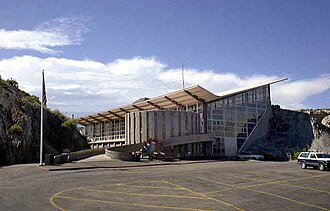
Mission 66 was a United States National Park Service ten-year program that was intended to dramatically expand Park Service visitor services by 1966, in time for the 50th anniversary of the establishment of the Park Service.
When the National Park Service was created in 1916, long-distance travel in North America was typically accomplished by train. There was no national road system, and airline travel was in its infancy. Railroads were closely involved in the development of visitor services at such parks as Grand Canyon National Park, Glacier National Park and Yellowstone National Park, and in many cases the railroads built and operated park visitor facilities.
With the development of the US highway system as a public works project during the Great Depression, many previously remote parks became accessible via good roads and inexpensive automobiles. The explosion in prosperity following World War II brought a tide of automobile-borne tourists that the parks were ill-equipped to receive. By the mid-1950s it was apparent that massive investment in park infrastructure was required. Mission 66 was conceived as the means to accommodate increased visitor numbers and to provide high-quality interpretation services.
While Mission 66 involved a variety of infrastructure projects such as roads, utilities and employee housing, the most visible components were interpretive facilities and visitor centers. Visitor centers were often the first point of contact between the Park Service and visitors, and the Park Service put considerable emphasis on the appropriate orientation and learning opportunities that visitor centers could provide.
